Just imagine how it feels to be on the dirty mud trenches of the Western Front or hearing the artillery in the distance during 1914. The Great War, or the World War 1 riddles, changed history as over 65 million soldiers were mustered on arms and no less than 16 million lives lost. Rather than thick textbooks, take a peek at this critical period in history using 125+ witty, thought-provoking riddles that are fun to read and informative.
Great to be read by history scholars, teachers, or those who liked to receive trivia questions on the war, those riddles explore the origins of the war, its main events and battles, technologies, cultural changes, and impressions left by it. For more historical puzzles, check out these World History Riddles.
In between the assassination of Archduke Franz Ferdinand and the Treat of Versailles, every puzzle challenges the mind to think but still makes history a fun and sweet deal.
What Are World War 1 Riddles?
World war I riddles are brain riddles to test what you know about the history of the war using word games and lateral thinking. They run over a period of July 28, 1914, to the November 11, 1918, and include basic questions, such as the year the war began, to more complicated challenges to find out what happened, such as the Christmas Truce or the Siege of Kut.
These riddles will be suitable to both novices and veterans, as they involve some actual historical entities, such as the Schlieffen Plan, ANZACs, or shell shock, to make them relevant and spot-on, but at the same time more beginners can get enlightened.
They are informative and amusing, which makes them suitable to use in classrooms, trivia nights, or as a personal study. To sharpen your riddle-solving skills, explore this Guide to Solving Riddles Like a Pro.
Benefits of Learning History Through Riddles
Why use riddles to learn about World War I? Here’s why they’re effective:
- Enhanced Memory: Recalling facts to solve riddles strengthens retention, like remembering the 300-day Battle of Verdun.
- Critical Thinking: Connecting clues hones analytical skills.
- Engagement: Interactive puzzles make history a game, keeping learners motivated.
- Social Bonding: The exchange of riddles within a group contributes to cooperation and communication.
According to educational research, gamified learning increases engagement by up to 40% compared to conventional methods. For more on the cognitive benefits, see Why Riddles Are Important for Kids’ Mental Development.
World War 1 Riddles Categorized
Organized into eight key categories, these 125+ riddles reflect critical aspects of World War I. Each category includes a curated selection, expanded to cover underrepresented entities like Paul von Hindenburg, the Red Cross, and shell shock, ensuring comprehensive coverage.
Causes & Origins
These riddles explore the events and ideologies that ignited the war, such as nationalism and alliances.
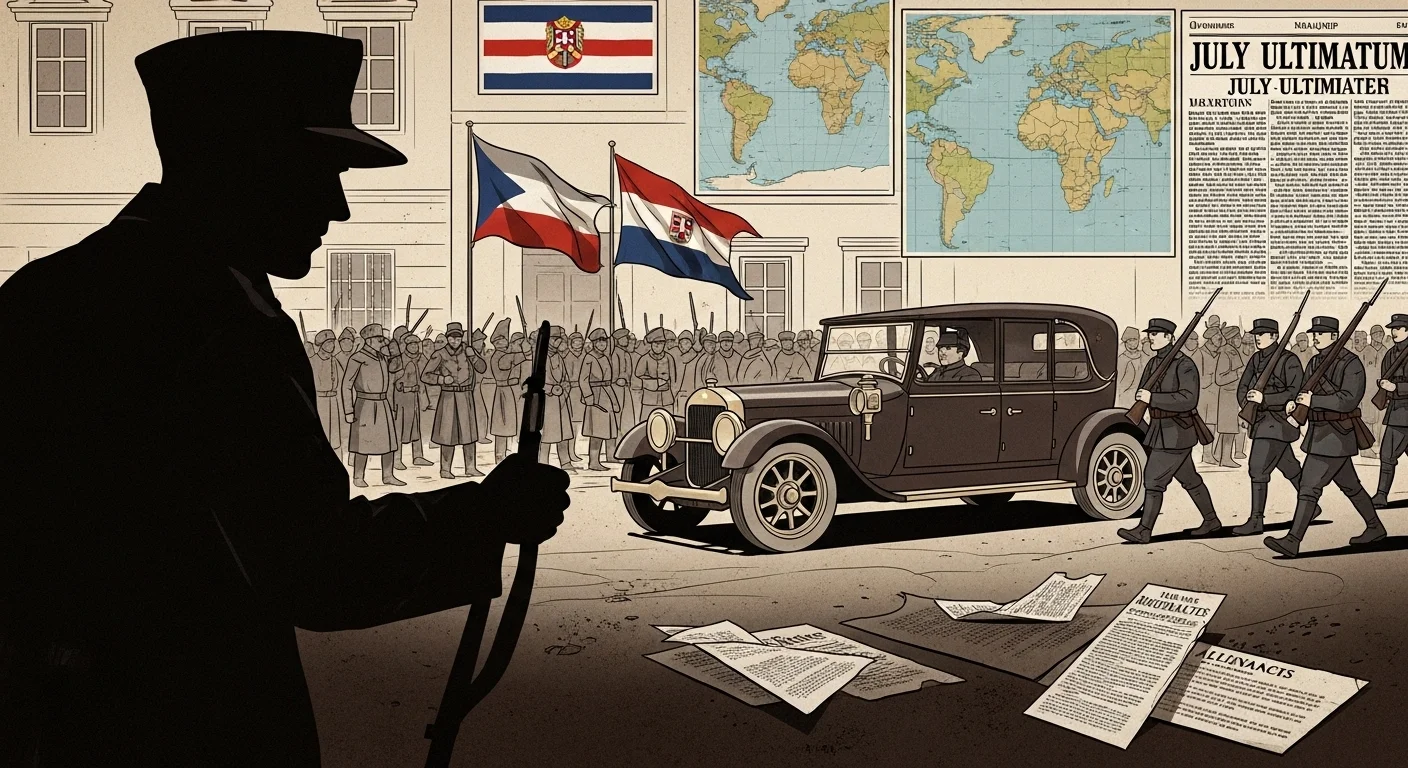
- Riddle: I sparked the war with shots in Sarajevo, a city simmering with tension. Who am I?
Hint: My actions triggered a global chain reaction.
Answer: Gavrilo Princip, the Serbian nationalist who assassinated Archduke Franz Ferdinand.
- Riddle: We were a web of treaties turning a regional conflict global. What are we?
Hint: Countries pledged mutual defense.
Answer: The alliance system.
- Riddle: I was Austria-Hungary’s ultimatum to Serbia, making war inevitable. What am I?
Hint: My demands were nearly impossible.
Answer: The July Ultimatum, issued in July 1914.
- Riddle: Ethnic conflicts in my region, the “powder keg of Europe,” lit the war’s fuse. What am I?
Hint: I’m where the assassination occurred.
Answer: The Balkans.
- Riddle: I’m the belief in national superiority, fueling European tensions. What am I?
Hint: It’s like excessive pride in your country.
Answer: Nationalism.
- Riddle: I’m the policy of expanding power through colonies, sparking rivalries. What am I?
Hint: Think global Monopoly for territories.
Answer: Imperialism.
- Riddle: I’m the buildup of armies and weapons, making nations nervous. What am I?
Hint: It’s like stockpiling for a showdown.
Answer: Militarism.
- Riddle: I’m the naval race between Britain and Germany, building dreadnoughts. What am I?
Hint: It’s a contest for sea dominance.
Answer: The arms race.
- Riddle: I’m the alliance of France, Russia, and Britain against the Central Powers. What am I?
Hint: We were three allies united.
Answer: The Triple Entente.
- Riddle: I’m the alliance of Germany, Austria-Hungary, and Italy at the war’s start. What am I?
Hint: One member later switched sides.
Answer: The Triple Alliance.
- Riddle: I’m Germany’s plan for imperial expansion, threatening rivals. What am I?
Hint: Drafted before the war, revealed later.
Answer: The September Program.
- Riddle: I’m the declaration that began the war, as Austria-Hungary targeted Serbia. What am I?
Hint: It followed a rejected ultimatum.
Answer: Declaration of war, July 28, 1914.
- Riddle: I’m the assassination that launched the July Crisis. What am I?
Hint: It involved an archduke and his wife.
Answer: Assassination of Archduke Franz Ferdinand.
- Riddle: I’m the rivalry for global dominance driving colonial competition. What am I?
Hint: It pushed nations to expand empires.
Answer: Imperial rivalry.
- Riddle: I’m the group behind the Sarajevo assassination, plotting for Slavic unity. What am I?
Hint: My name suggests secrecy and danger.
Answer: The Black Hand.
- Riddle: I led the Black Hand, orchestrating the spark of war. Who am I?
Hint: I was a Serbian military officer.
Answer: Dragutin Dimitrijević.
- Riddle: I’m the archduke whose death ignited the war. Who am I?
Hint: I was heir to Austria-Hungary’s throne.
Answer: Franz Ferdinand.
- Riddle: I’m the region where Slavic nationalism clashed with empires. What am I?
Hint: I’m a peninsula with a turbulent history.
Answer: The Balkans.
Key Events
These riddles cover pivotal moments, from the war’s outbreak to turning points.
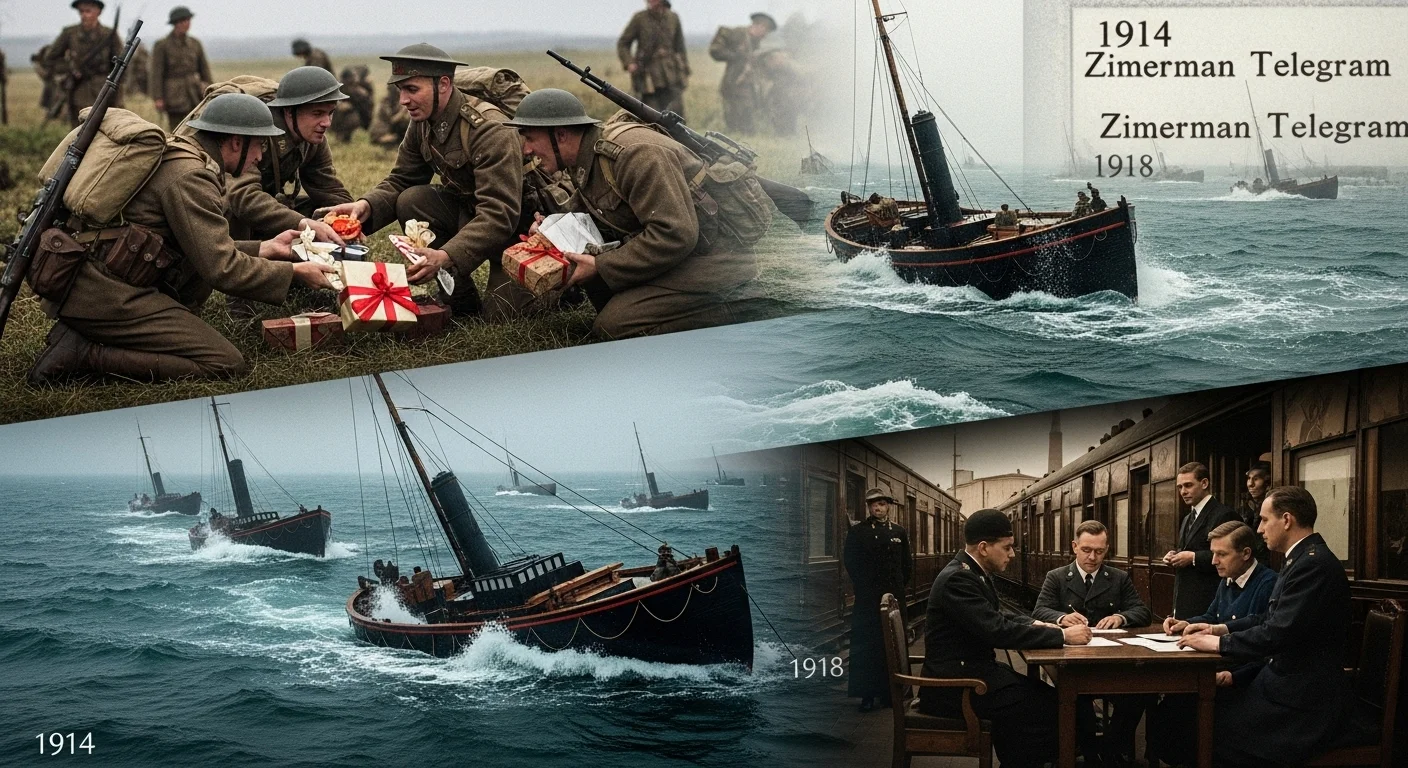
- Riddle: Europe’s lights dimmed as we declared war, starting over four years of conflict. What month and year?
Hint: It launched the Great War.
Answer: August 1914.
- Riddle: I allowed Germany to invade neutral Belgium to outmaneuver France. What am I?
Hint: A bold but flawed strategy.
Answer: The Schlieffen Plan.
- Riddle: Soldiers ceased fire and shared greetings in No Man’s Land. What year was I?
Hint: A rare moment of peace at Christmas.
Answer: 1914, during the Christmas Truce.
- Riddle: I was the passenger ship sunk by a German U-boat, enraging the U.S. What am I?
Hint: I sank in 1915, killing 1,198.
Answer: The sinking of the Lusitania.
- Riddle: I was the secret message offering Mexico land to ally with Germany. What am I?
Hint: Intercepted by Britain in 1917.
Answer: The Zimmerman Telegram.
- Riddle: I overthrew the Tsar, leading to Russia’s exit from the war. What am I?
Hint: I began in 1917, reshaping Russia.
Answer: The Russian Revolution.
- Riddle: I ended fighting on November 11, 1918, in a railway carriage. What am I?
Hint: Signed at 11 a.m.
Answer: The Armistice of Compiègne.
- Riddle: I was the naval clash with no clear winner, fought in 1916. What am I?
Hint: The war’s largest sea battle.
Answer: The Battle of Jutland.
- Riddle: I was Germany’s tactic to starve Britain via submarine attacks. What am I?
Hint: It angered neutral nations.
Answer: Unrestricted submarine warfare.
- Riddle: I closed the Dardanelles when the Ottoman Empire joined the war. What am I?
Hint: I disrupted trade in 1914.
Answer: Ottoman entry into World War I.
- Riddle: I secretly divided the Middle East between Britain and France. What am I?
Hint: I shaped modern borders.
Answer: The Sykes-Picot Agreement.
- Riddle: I prompted U.S. entry by resuming submarine attacks in 1917. What am I?
Hint: It shifted the war’s balance.
Answer: Resumption of unrestricted submarine warfare.
- Riddle: I was Ireland’s uprising against British rule in 1916. What am I?
Hint: It led to later independence.
Answer: The Easter Rising.
- Riddle: I supported a Jewish homeland in Palestine, issued by Britain. What am I?
Hint: I was declared in 1917.
Answer: The Balfour Declaration.
- Riddle: I brought the U.S. into the war in April 1917. What am I?
Hint: I followed German provocations.
Answer: U.S. entry into World War I.
- Riddle: I was the 1919 Paris conference negotiating peace terms. What am I?
Hint: I redrew global maps.
Answer: The Paris Peace Conference.
- Riddle: I was Germany’s 1918 offensive that nearly broke Allied lines. What am I?
Hint: Known as the Spring Offensive.
Answer: The German Spring Offensive.
- Riddle: I let Russia exit the war, freeing German troops in 1918. What am I?
Hint: Signed in Brest-Litovsk.
Answer: The Treaty of Brest-Litovsk.
- Riddle: I was Britain’s plan to knock out the Ottomans via a strait. What am I?
Hint: It failed at Gallipoli.
Answer: The Dardanelles Campaign.
- Riddle: I was the British politician who pushed for the Gallipoli campaign. Who am I?
Hint: I was First Lord of the Admiralty.
Answer: Winston Churchill.
Major Battles
These riddles focus on significant battles, known for their scale and impact. For more war-related puzzles, try these War Riddles.
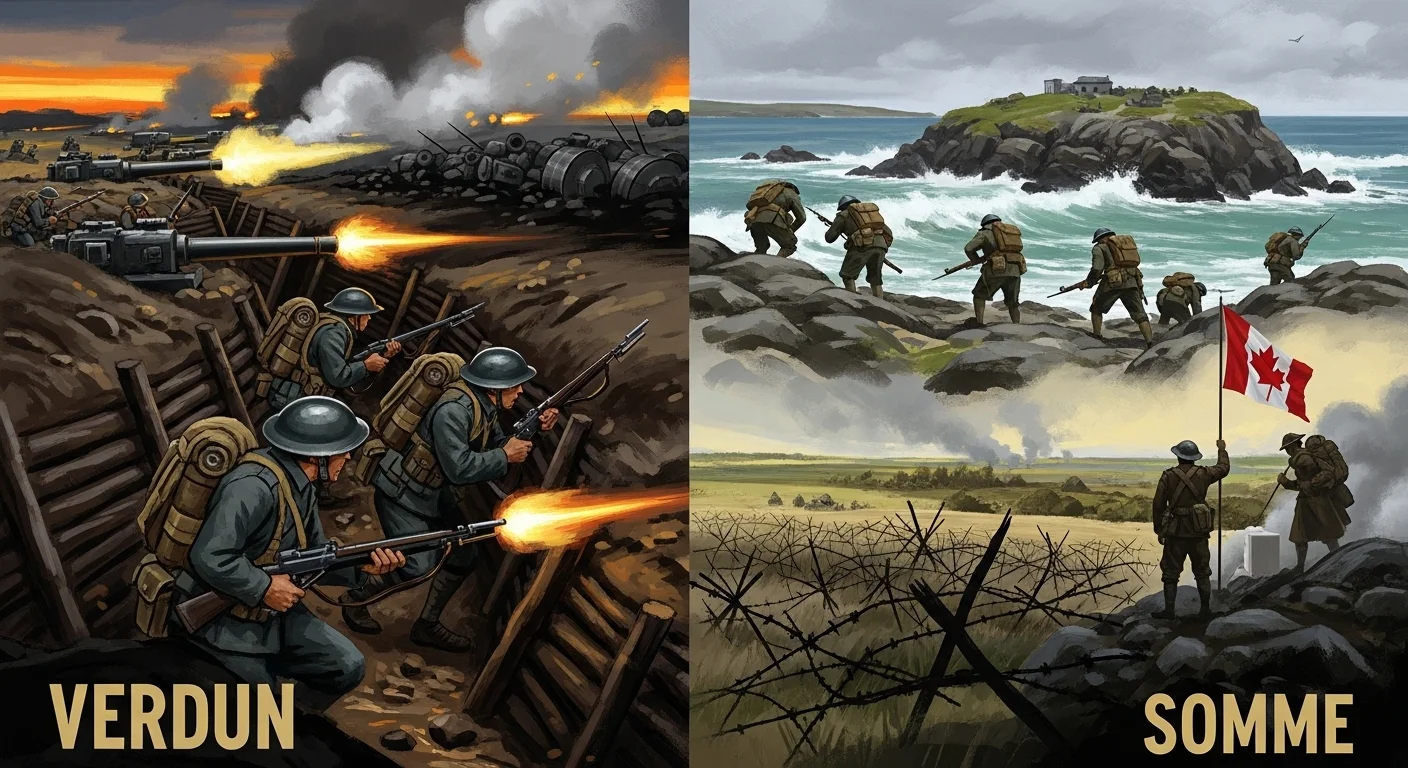
- Riddle: Lasting over 300 days with over 1 million casualties, I symbolized futile slaughter. Where was I?
Hint: Fought in 1916 in France.
Answer: The Battle of Verdun.
- Riddle: We were Australian and New Zealand troops, heroic at Gallipoli. Who are we?
Hint: Our acronym is iconic.
Answer: The ANZACs.
- Riddle: I was an amphibious invasion stopped by the Turks in 1915. Where was I?
Hint: I aimed for Constantinople.
Answer: The Gallipoli Campaign.
- Riddle: I saw over 1 million casualties, with 57,470 on day one in 1916. What am I?
Hint: Fought along a French river.
Answer: The Battle of the Somme.
- Riddle: My muddy fields defined the war’s futility in 1917 Belgium. What am I?
Hint: Also called the Third Battle of Ypres.
Answer: The Battle of Passchendaele.
- Riddle: I was Italy’s 1917 defeat by Austro-Hungarian and German forces. What am I?
Hint: I led to a major retreat.
Answer: The Battle of Caporetto.
- Riddle: I was Germany’s 1914 victory over Russia in East Prussia. What am I?
Hint: A major early win for Germany.
Answer: The Battle of Tannenberg.
- Riddle: I stopped Germany near Paris in 1918, leading to the Armistice. What am I?
Hint: A turning point in July 1918.
Answer: The Second Battle of the Marne.
- Riddle: I saw 250 ships clash at sea with no clear winner in 1916. What am I?
Hint: The war’s largest naval battle.
Answer: The Battle of Jutland.
- Riddle: I introduced tanks in large numbers in 1917. What am I?
Hint: A technological shift in France.
Answer: The Battle of Cambrai.
- Riddle: I launched the Allied pushback in 1918, starting the war’s end. What am I?
Hint: Part of the Hundred Days Offensive.
Answer: The Battle of Amiens.
- Riddle: I was the series of victories ending the war in 1918. What am I?
Hint: I began with Amiens.
Answer: The Hundred Days Offensive.
- Riddle: I saw Canadians capture a key ridge in 1917. What am I?
Hint: A symbol of Canadian pride.
Answer: The Battle of Vimy Ridge.
- Riddle: I was where U.S. marines fought bravely in 1918. What am I?
Hint: A forest battle for Americans.
Answer: The Battle of Belleau Wood.
- Riddle: I used massive mines to destroy German lines in 1917. What am I?
Hint: My craters remain in Belgium.
Answer: The Battle of Messines.
- Riddle: I saw Australians use new tactics in 1918 under John Monash. What am I?
Hint: A quick victory in France.
Answer: The Battle of Hamel.
- Riddle: I stopped Germany just outside Paris in 1914. What am I?
Hint: I led to a trench stalemate.
Answer: The First Battle of the Marne.
- Riddle: I saw British forces capture Jerusalem in 1917. What am I?
Hint: Part of the Middle East campaign.
Answer: The Battle of Megiddo.
- Riddle: I was Serbia’s 1914 stand against Austria-Hungary. What am I?
Hint: I showed early resilience.
Answer: The Battle of Cer.
- Riddle: I was a stalemate in the Balkans’ Salonika region. What am I?
Hint: A sideshow to the Western Front.
Answer: The Macedonian Front.
- Riddle: I was Germany’s 1914 siege of a French fortress town. What am I?
Hint: I had 15 forts and 435 guns.
Answer: The Siege of Maubeuge.
- Riddle: I saw British forces retake a town on the war’s last day. What am I?
Hint: I was symbolic after an early loss.
Answer: The Battle of Mons (1918).
- Riddle: I was Russia’s 1914 defeat in Poland after Tannenberg. What am I?
Hint: Another German victory.
Answer: The Battle of the Masurian Lakes.
- Riddle: I saw British forces use a creeping barrage in 1917. What am I?
Hint: Fought in northern France.
Answer: The Battle of Arras.
- Riddle: I was the British defeat in Mesopotamia, trapped by Ottomans. What am I?
Hint: I was a 1915–1916 siege.
Answer: The Siege of Kut.
- Riddle: I was the region of multiple bloody battles, including Ypres. What am I?
Hint: Known for poppies and mud.
Answer: Flanders.
Weapons & Technology
These riddles highlight the war’s innovative and devastating technologies. For more on military advancements, see these Weapons Riddles.
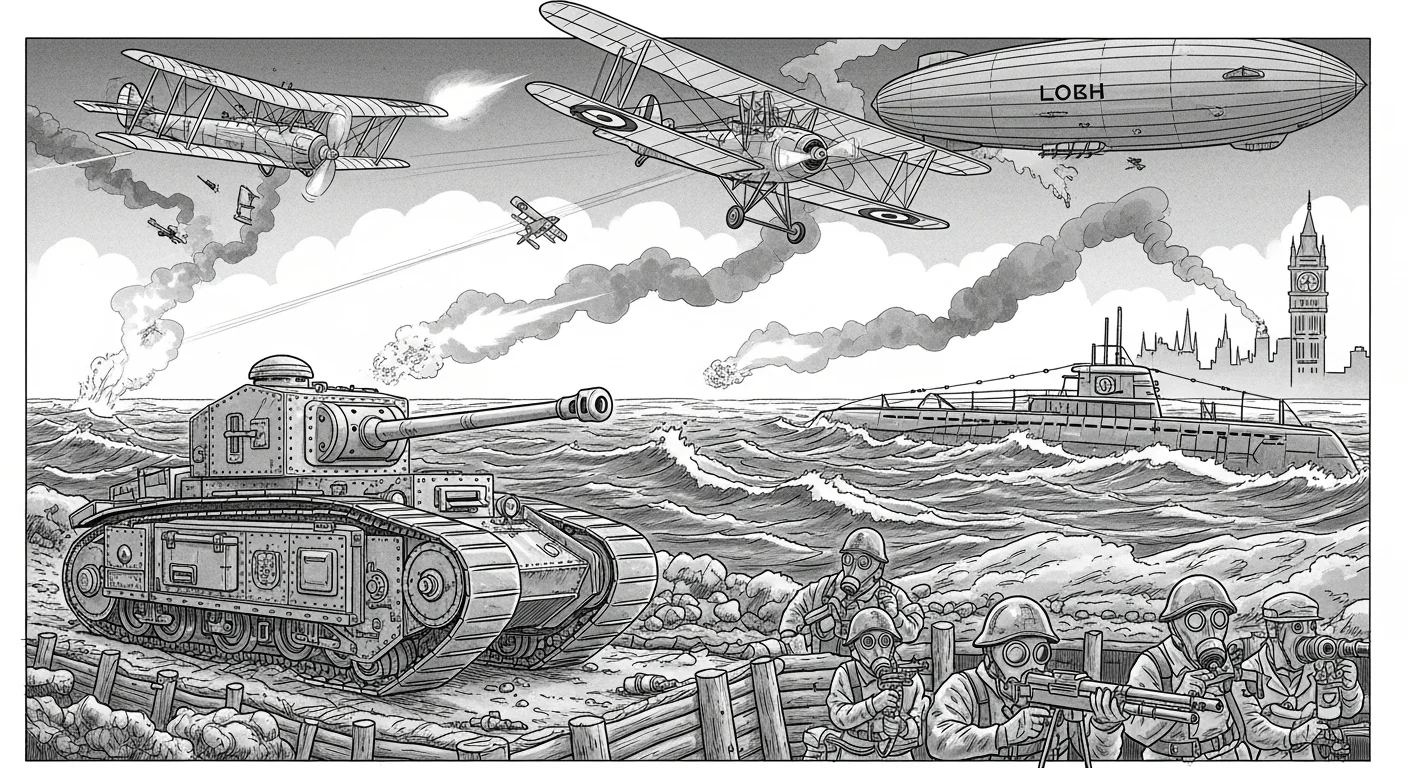
- Riddle: I caused horrific injuries and was later banned. What am I?
Hint: Soldiers wore masks to survive me.
Answer: Poison gas.
- Riddle: I crossed No Man’s Land, changing warfare in 1916. What am I?
Hint: The British debuted me at Flers-Courcelette.
Answer: Tanks.
- Riddle: I sank ships from beneath the waves, blockading Britain. What am I?
Hint: Germany’s submarine weapon.
Answer: U-boat.
- Riddle: I cut down infantry, causing trench stalemates. What am I?
Hint: A rapid-firing weapon.
Answer: Machine gun.
- Riddle: I flew for reconnaissance and bombing, starting air warfare. What am I?
Hint: I evolved rapidly during the war.
Answer: Airplane.
- Riddle: I protected soldiers from deadly gas clouds. What am I?
Hint: Essential in trenches.
Answer: Gas mask.
- Riddle: I shot flames to clear trenches in close combat. What am I?
Hint: A terrifying German weapon.
Answer: Flamethrower.
- Riddle: I fired shells over long distances, shaping trench warfare. What am I?
Hint: I caused massive destruction.
Answer: Artillery.
- Riddle: I was the first tank, named after a water carrier in 1916. What am I?
Hint: I debuted at the Somme.
Answer: Mark I tank.
- Riddle: I was Germany’s submarine strategy that provoked the U.S. What am I?
Hint: No ship was safe from me.
Answer: Unrestricted submarine warfare.
- Riddle: I connected troops over long distances for coordination. What am I?
Hint: Vital for attack planning.
Answer: Field telephone.
- Riddle: I was Germany’s airship bombing London. What am I?
Hint: I caused civilian fear.
Answer: Zeppelin.
- Riddle: I fired explosive shells in massive barrages. What am I?
Hint: A heavy artillery piece.
Answer: Howitzer.
- Riddle: I detected enemy planes using sound before radar. What am I?
Hint: An early detection tool.
Answer: Acoustic locator.
- Riddle: I entangled soldiers in trenches, slowing attacks. What am I?
Hint: A spiky obstacle.
Answer: Barbed wire.
- Riddle: I let snipers fire safely from trenches. What am I?
Hint: I used mirrors to aim.
Answer: Periscope rifle.
Impacts & Effects
These riddles explore the war’s lasting consequences, from treaties to societal shifts.
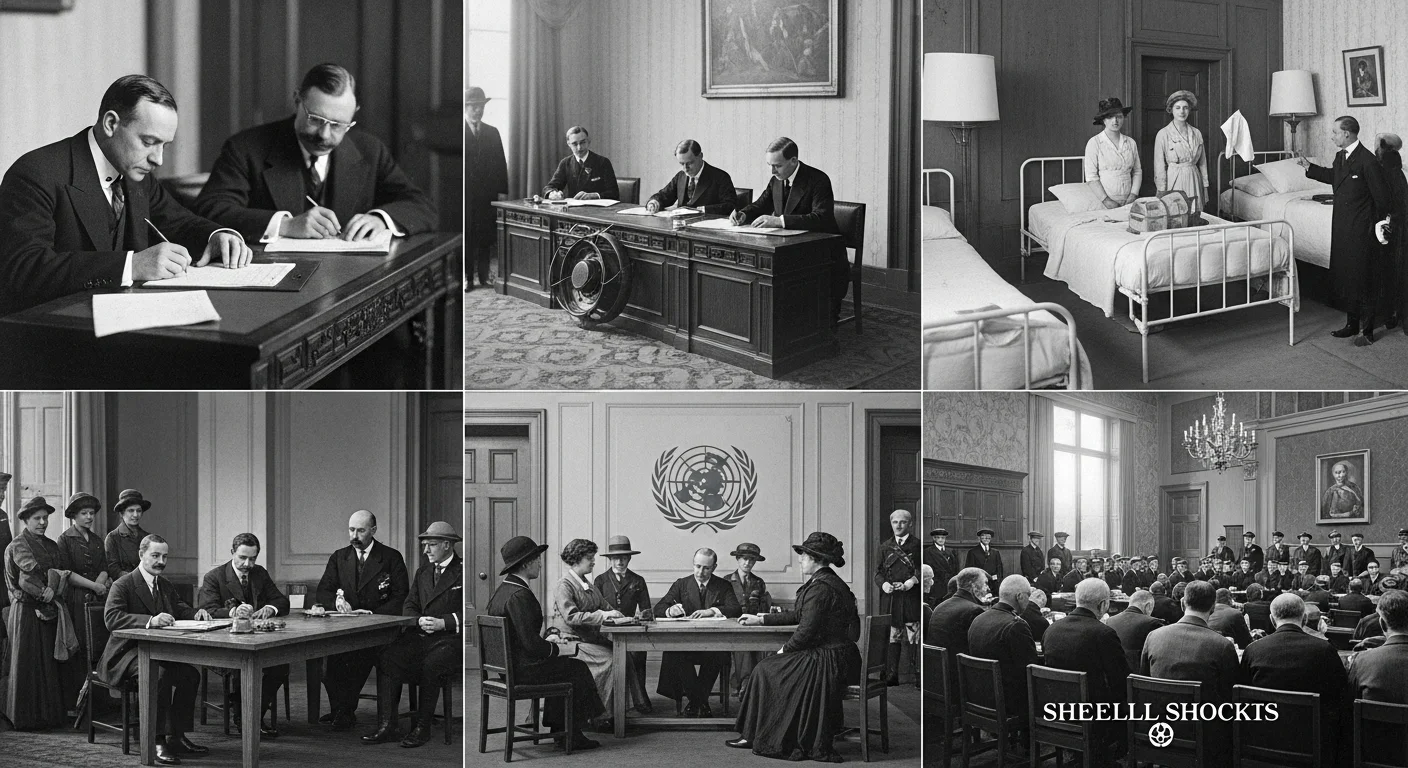
- Riddle: I imposed harsh terms on Germany, sowing seeds for World War II. What am I?
Hint: Signed in 1919 with reparations.
Answer: The Treaty of Versailles.
- Riddle: I killed more than the war in 1918–1919, spreading globally. What am I?
Hint: A deadly pandemic.
Answer: The Spanish Flu.
- Riddle: I was formed to prevent wars but failed by 1939. What am I?
Hint: Precursor to the United Nations.
Answer: The League of Nations.
- Riddle: I ended four empires: German, Austro-Hungarian, Russian, and Ottoman. What am I?
Hint: I was the war itself.
Answer: World War I.
- Riddle: I was the new nation of Czechs and Slovaks, born in 1918. What am I?
Hint: Formed from Austro-Hungarian lands.
Answer: Czechoslovakia.
- Riddle: I lost Alsace-Lorraine and much territory post-war. What am I?
Hint: I was blamed for the war.
Answer: Germany.
- Riddle: I gained momentum as women worked in war factories. What am I?
Hint: I led to voting rights.
Answer: Women’s suffrage.
- Riddle: I made German money worthless in the 1920s. What am I?
Hint: A post-war economic crisis.
Answer: German hyperinflation.
- Riddle: I was the literary movement of disillusioned post-war writers. What am I?
Hint: Think Hemingway and Fitzgerald.
Answer: The Lost Generation.
- Riddle: I burdened Germany’s economy with post-war payments. What am I?
Hint: Part of the Treaty of Versailles.
Answer: War reparations.
- Riddle: I redrew borders, creating nations like Poland. What am I?
Hint: I followed the Paris Peace Conference.
Answer: Post-war border changes.
- Riddle: I was the social upheaval from returning soldiers. What am I?
Hint: I shook class structures.
Answer: Social disruption.
- Riddle: I was the rise of communism post-war, inspired by Russia. What am I?
Hint: A new ideology spread.
Answer: Spread of communism.
- Riddle: I was the psychological toll on soldiers, later called PTSD. What am I?
Hint: I haunted veterans’ minds.
Answer: Shell shock.
- Riddle: I mobilized entire economies for war production. What am I?
Hint: I transformed industries.
Answer: War economy.
- Riddle: I was the generation scarred by the war’s horrors. What am I?
Hint: Many felt lost afterward.
Answer: The Lost Generation.
Key Figures
These riddles focus on individuals who shaped the war.
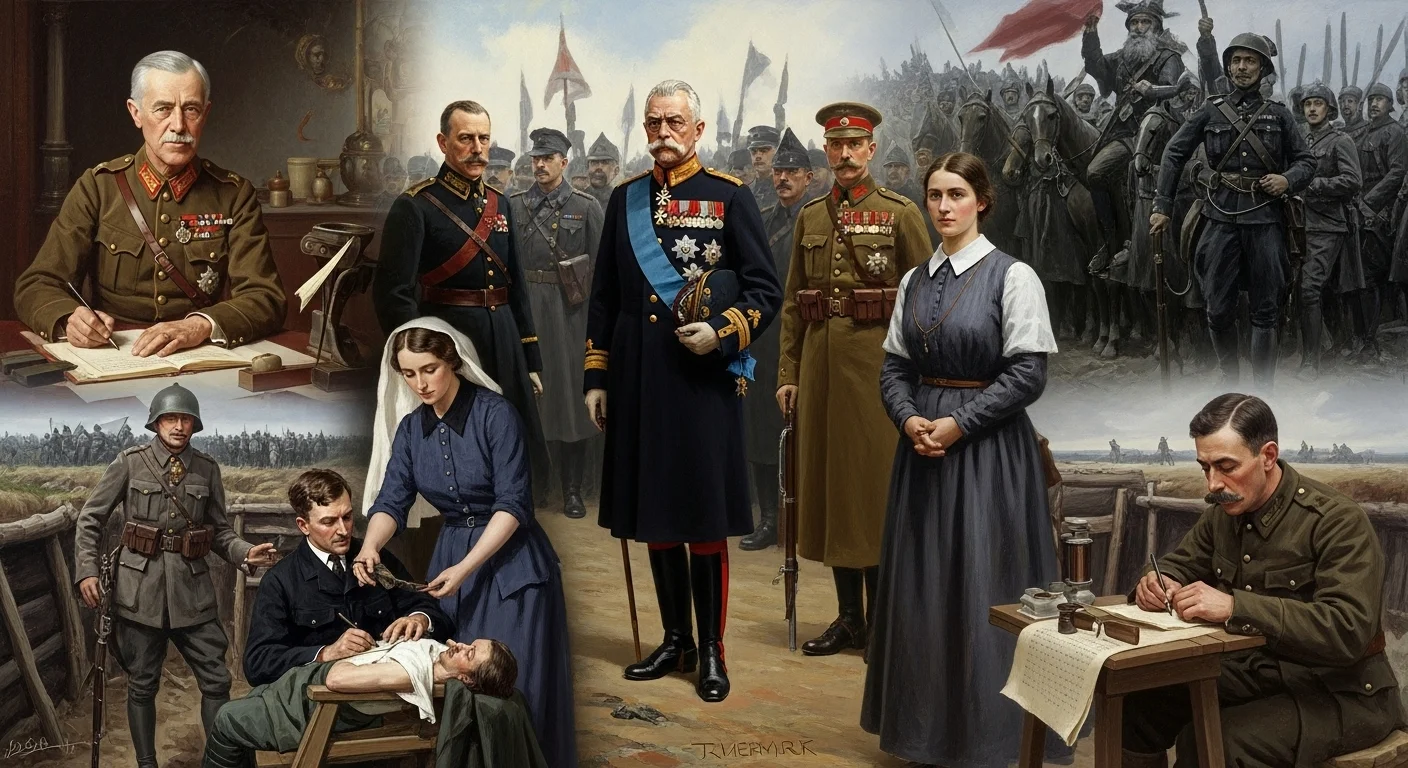
- Riddle: I proposed the Fourteen Points for peace as U.S. President. Who am I?
Hint: My middle name is Wilson.
Answer: Woodrow Wilson.
- Riddle: I was Germany’s Emperor, escalating tensions pre-war. Who am I?
Hint: Known for my mustache.
Answer: Kaiser Wilhelm II.
- Riddle: I was Russia’s last Tsar, toppled by the war. Who am I?
Hint: My family was executed in 1918.
Answer: Tsar Nicholas II.
- Riddle: I led Britain as Prime Minister through much of the war. Who am I?
Hint: I took over in 1916.
Answer: David Lloyd George.
- Riddle: I was France’s “Tiger” at the peace conference. Who am I?
Hint: I demanded harsh German terms.
Answer: Georges Clemenceau.
- Riddle: I led the Bolsheviks, pulling Russia out of the war. Who am I?
Hint: I spread communism globally.
Answer: Vladimir Lenin.
- Riddle: I defended Gallipoli and founded modern Turkey. Who am I?
Hint: My surname means “Father of the Turks.”
Answer: Mustafa Kemal Atatürk.
- Riddle: I led British forces at the Somme, criticized for losses. Who am I?
Hint: A controversial general.
Answer: Douglas Haig.
- Riddle: I devised Germany’s failed plan to invade France. Who am I?
Hint: My name is tied to a strategy.
Answer: Alfred von Schlieffen.
- Riddle: I led U.S. forces in Europe, nicknamed “Black Jack.” Who am I?
Hint: I commanded in 1918.
Answer: John J. Pershing.
- Riddle: I was Russia’s general, defeated at Tannenberg. Who am I?
Hint: I led the Second Army in 1914.
Answer: Alexander Samsonov.
- Riddle: I was the British nurse executed for aiding soldiers. Who am I?
Hint: My death fueled propaganda.
Answer: Edith Cavell.
- Riddle: I defended Verdun, saying “They shall not pass.” Who am I?
Hint: A French national hero.
Answer: Philippe Pétain.
- Riddle: I commanded Britain’s Grand Fleet at Jutland. Who am I?
Hint: I checked Germany’s navy.
Answer: John Jellicoe.
- Riddle: I led Germany to victory at Tannenberg with Ludendorff. Who am I?
Hint: I later became Germany’s president.
Answer: Paul von Hindenburg.
- Riddle: I co-led Germany’s Spring Offensive with Hindenburg. Who am I?
Hint: A strategic German general.
Answer: Erich Ludendorff.
- Riddle: I wrote “Dulce et Decorum Est,” capturing trench horrors. Who am I?
Hint: A British war poet.
Answer: Wilfred Owen.
- Riddle: I pushed for Gallipoli as Britain’s naval leader. Who am I?
Hint: I later became Prime Minister.
Answer: Winston Churchill.
- Riddle: I led the U.S. food conservation campaign, saving supplies. Who am I?
Hint: I later became President.
Answer: Herbert Hoover.
- Riddle: I was the Canadian doctor who wrote “In Flanders Fields.” Who am I?
Hint: My poem honors fallen soldiers.
Answer: John McCrae.
Propaganda & Culture
These riddles explore propaganda, art, and cultural shifts during the war.
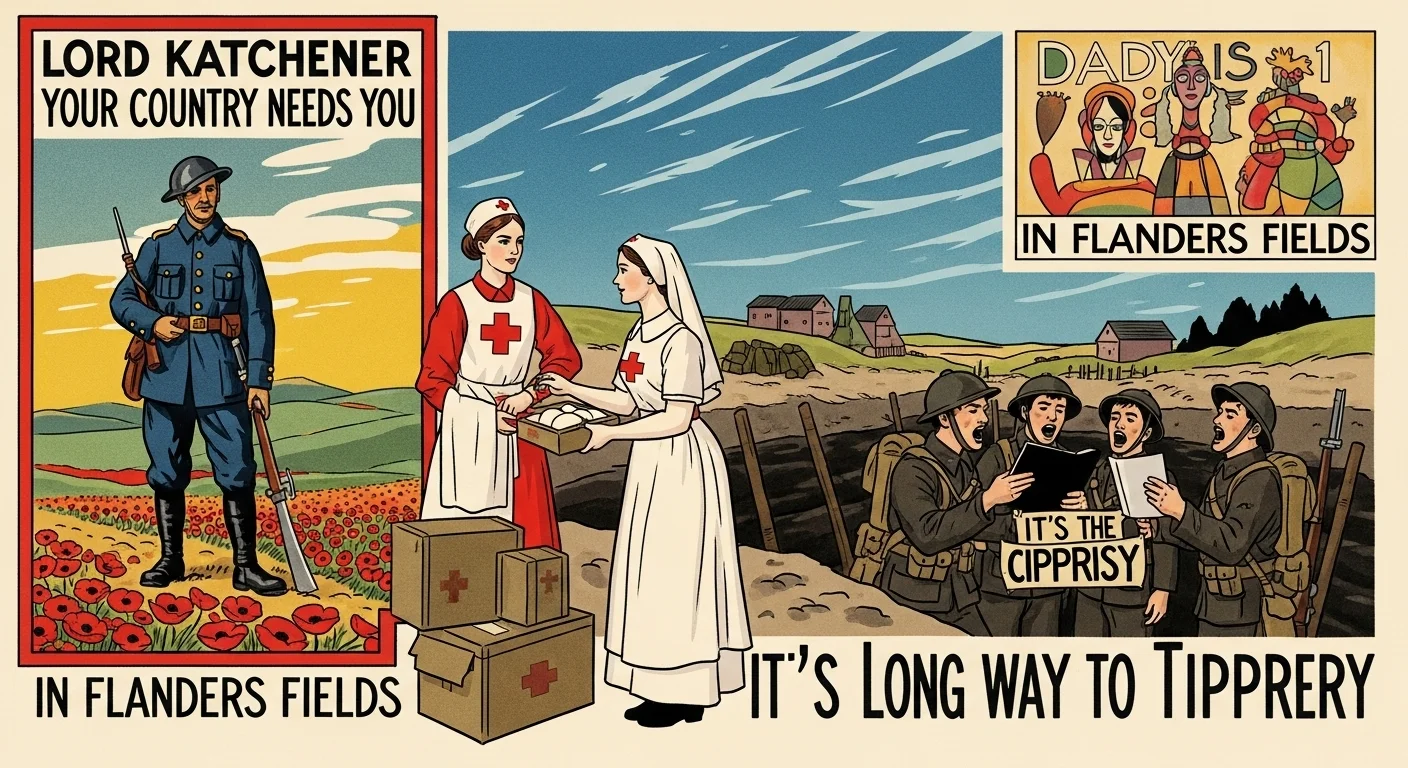
- Riddle: I was Britain’s poster urging enlistment with a pointing figure. What am I?
Hint: I said, “Your Country Needs You!”
Answer: Lord Kitchener’s recruitment poster.
- Riddle: I exaggerated enemy atrocities to rally support. What am I?
Hint: I shaped public opinion.
Answer: Propaganda.
- Riddle: I was Germany’s nickname for its soldiers in patriotic songs. What am I?
Hint: A term for a foot soldier.
Answer: Fritz.
- Riddle: I was Britain’s term for Germans in mocking cartoons. What am I?
Hint: It rhymes with a sausage.
Answer: Hun.
- Riddle: I was the song dreaming of home, inspiring Allied troops. What am I?
Hint: It’s about Tipperary.
Answer: “It’s a Long Way to Tipperary.”
- Riddle: I was the poem about poppies, written after Ypres. What am I?
Hint: A Canadian doctor wrote me.
Answer: “In Flanders Fields.”
- Riddle: I encouraged women to work in British factories. What am I?
Hint: I featured women in overalls.
Answer: Munitions worker campaign.
- Riddle: I was the U.S. poster urging navy enlistment with a woman’s wish. What am I?
Hint: Known as the Christy Girl.
Answer: Christy Girl recruitment poster.
- Riddle: I was Germany’s film medium to boost morale. What am I?
Hint: I showed heroic soldiers.
Answer: War propaganda films.
- Riddle: I was Britain’s sensationalist newspaper spreading anti-German tales. What am I?
Hint: Known for bold headlines.
Answer: The Daily Mail.
- Riddle: I was the art movement born in Switzerland, rejecting war’s values. What am I?
Hint: I embraced chaos and absurdity.
Answer: Dadaism.
- Riddle: I was soldiers’ letters, scrubbed of military secrets. What am I?
Hint: I was carefully written home.
Answer: Censored mail.
- Riddle: I saved food for U.S. soldiers with “Meatless Mondays.” What am I?
Hint: Led by Herbert Hoover.
Answer: Food conservation campaign.
- Riddle: I honored British women for factory work. What am I?
Hint: A wartime medal for women.
Answer: Munitions Workers’ Medal.
- Riddle: I was the songs and dances lifting wartime spirits. What am I?
Hint: I kept morale high.
Answer: Wartime entertainment.
- Riddle: I mocked the Kaiser in British cartoons for Punch. Who am I?
Hint: A satirical artist.
Answer: Bernard Partridge.
- Riddle: I banned negative news in Germany to control morale. What am I?
Hint: I silenced the press.
Answer: Press censorship.
- Riddle: I aided wounded soldiers with medical care across fronts. What am I?
Hint: My symbol is a red cross.
Answer: Red Cross.
- Riddle: I supported soldiers’ welfare with recreation and supplies. What am I?
Hint: My initials are YMCA.
Answer: Young Men’s Christian Association.
Military Strategies & Tactics
These riddles focus on strategies and tactics defining the war. For more on military themes, explore these Military Riddles.
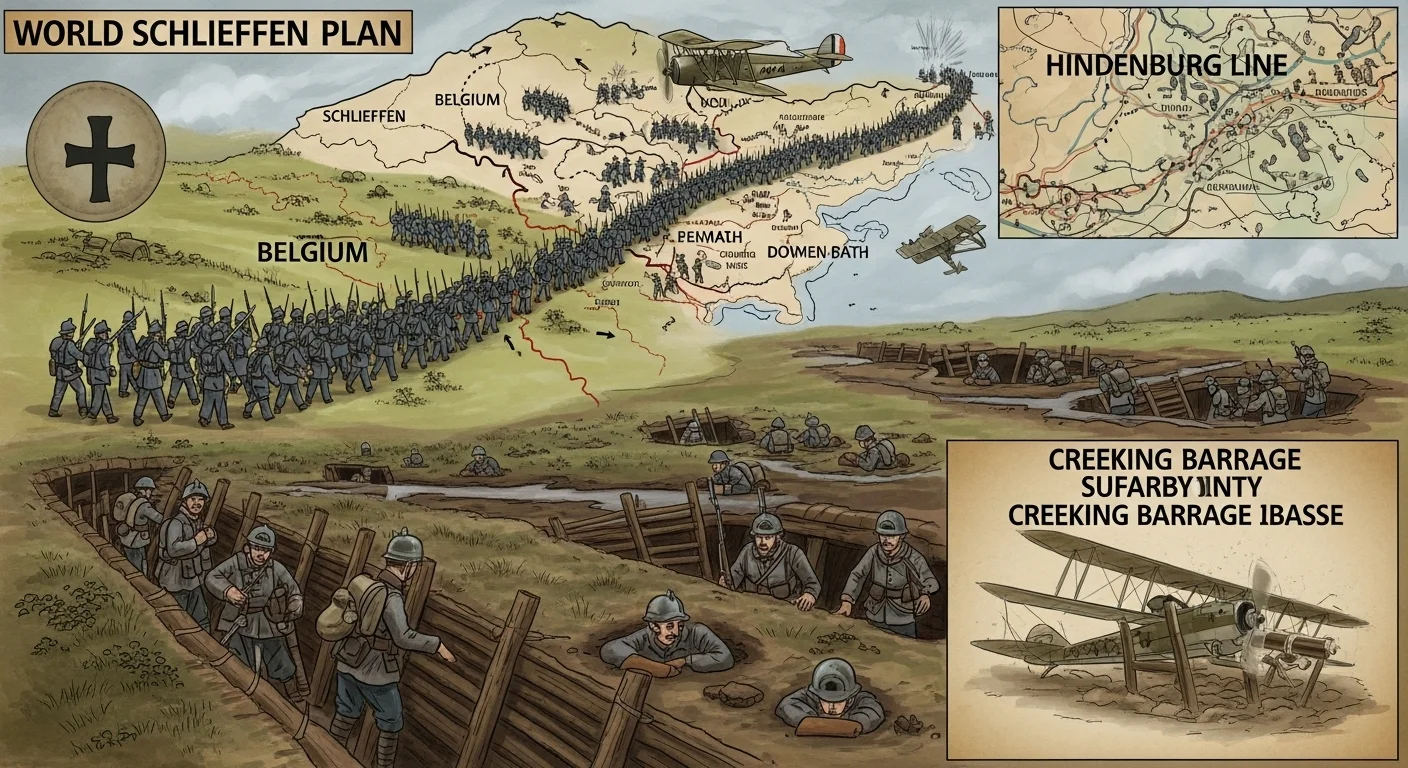
- Riddle: I was Germany’s plan to swiftly defeat France via Belgium. What am I?
Hint: I aimed for a six-week victory.
Answer: The Schlieffen Plan.
- Riddle: I was the ditch-based defense system of the Western Front. What am I?
Hint: I stalled movement for years.
Answer: Trench warfare.
- Riddle: I softened enemy lines with artillery before an attack. What am I?
Hint: I preceded infantry charges.
Answer: Artillery barrage.
- Riddle: I starved Germany by blocking its ports. What am I?
Hint: A British naval strategy.
Answer: Naval blockade.
- Riddle: I planted explosives under enemy trenches. What am I?
Hint: Used at Messines in 1917.
Answer: Tunneling.
- Riddle: I was Germany’s rapid assault tactic in 1918. What am I?
Hint: Part of the Spring Offensive.
Answer: Stormtrooper tactics.
- Riddle: I moved artillery fire with advancing infantry. What am I?
Hint: I protected Allied troops.
Answer: Creeping barrage.
- Riddle: I wore down enemies through prolonged battles. What am I?
Hint: I caused massive losses at Verdun.
Answer: Attrition warfare.
- Riddle: I used planes to spot enemy positions. What am I?
Hint: I improved artillery aim.
Answer: Aerial reconnaissance.
- Riddle: I disrupted Allied shipping with German submarines. What am I?
Hint: I provoked U.S. entry.
Answer: Unrestricted submarine warfare.
- Riddle: I was Germany’s retreat to fortified lines in 1917. What am I?
Hint: Named after a German general.
Answer: Hindenburg Line retreat.
- Riddle: I aimed to knock out the Ottomans via Gallipoli. What am I?
Hint: A failed Allied plan.
Answer: Dardanelles Campaign.
- Riddle: I coordinated multiple attacks to confuse enemies. What am I?
Hint: Used in the Hundred Days Offensive.
Answer: Combined arms offensive.
- Riddle: I held ground despite heavy losses. What am I?
Hint: Common on the Western Front.
Answer: Defensive warfare.
- Riddle: I used outdated cavalry charges in open battles. What am I?
Hint: Common in the Middle East.
Answer: Cavalry charges.
- Riddle: I was Germany’s feinting attacks to mislead Allies. What am I?
Hint: Used in 1918 to stretch lines.
Answer: Diversionary attacks.
- Riddle: I paired tanks with infantry for success at Amiens. What am I?
Hint: A 1918 Allied tactic.
Answer: Tank-infantry coordination.
- Riddle: I cut off enemy supplies to weaken them. What am I?
Hint: I hurt Germany by 1918.
Answer: Logistics disruption.
- Riddle: I was the German code for secure communication. What am I?
Hint: Named with letters like ADFGVX.
Answer: ADFGVX cipher.
- Riddle: I mobilized entire nations’ resources for war. What am I?
Hint: I transformed economies.
Answer: War economy.
Conclusion
World War I, spanning 1914–1918, redefined global politics, economies, and societies. These 125+ riddles make this period engaging, informative, and accessible, touching on causes, battles, technologies, and cultural impacts. For more on later conflicts, try these World War 2 Riddles.
Whether you’re a teacher, student, or history enthusiast, these puzzles offer a fresh way to explore the stories that shaped our world. Share them with friends, use them in lessons, or challenge yourself to create more! For additional historical context, visit the Imperial War Museums.
Frequently Asked Questions (FAQs)
What are some questions about WW1?
What triggered World War I?
Which countries formed the Central Powers?
Why was the Battle of Verdun significant?
How did the war end?
What are 5 interesting facts about WW1?
Sparked by Archduke Franz Ferdinand’s assassination in 1914.
Introduced tanks, airplanes, and poison gas to warfare.
Mobilized over 65 million soldiers, with 16 million casualties.
The Treaty of Versailles fueled future conflicts with harsh terms.
Collapsed four empires: German, Austro-Hungarian, Russian, and Ottoman.
What was World War 1’s real name?
It was called the Great War until World War II began in 1939.
What were WW1’s nicknames?
The Great War
The War to End All Wars
The World War
What was the code used in World War 1?
The German ADFGVX cipher was a key encryption method on the Western Front. Learn more at the National Cryptologic Museum.
Who broke first in World War I?
The Central Powers, led by Germany, sought an armistice on November 11, 1918. For a detailed timeline, see History.com.